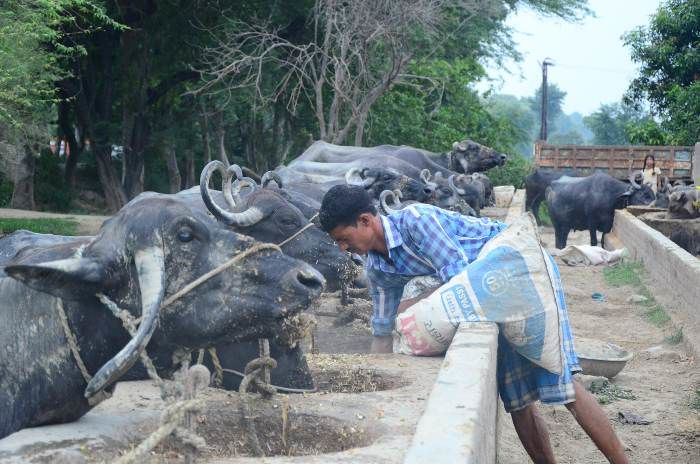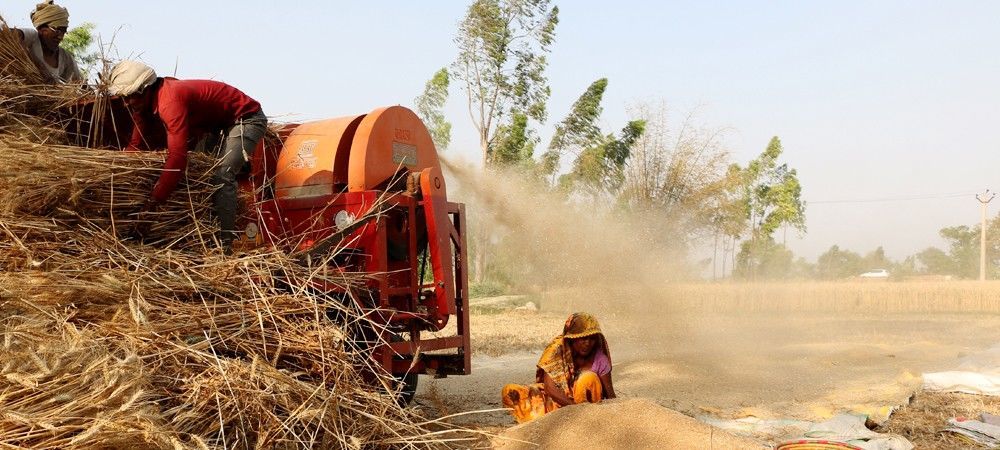Costly fodder adds to the woes of cattle farmers as they were already struggling to sell milk
The price of dry fodder, usually sold at Rs 600-700 per quintal, has reached Rs 800-1,000. Also, its shortage has further increased as harvesting of crops has been affected due to the lockdown


The price of dry fodder, usually sold at Rs 600-700 per quintal has reached Rs 800-1,000. This adds to the woes of already distressed cattle farmers who are unable to sell milk due to the lockdown and now also have to worry about feeding the animals if they do not get fodder.
Manish Bharti, a resident of Meerut in Uttar Pradesh, is one of the largest cattle farmers in the district, but he is now upset due to the lockdown. He said: “The milk, which is usually sold at Rs 40-45 per litre is now selling at Rs 35-36 and the prices of cattle feed and dry fodder are skyrocketing. If you sell milk cheaply, how will you be able to feed expensive fodder? The bhusa (dry fodder) selling earlier for Rs 600-700 per quintal, has now reached over Rs 1,000. Now, how would a cattle farmer manage?”
Sudha Pandey, who runs a dairy farm in Sitapur, is feeding leftover from the mustard crop and straw to her cattle nowadays because her dry fodder supply has run out and she is unable to replenish it due to the lockdown. She said: “Somehow, we are managing to feed our animals through mustard and straw. When milk is not being sold, how would we buy costly bhusa? Around this time, there is a straw shortage every year and only when the wheat harvest begins, bhusa becomes available.”

All these problems faced by the cattle farmers are due to non- harvesting of rabi crops since there has been a 21-day lockdown in the country since March 25. The harvesting of rabi crops like wheat, pulses, oilseeds has stopped due to lack of labourers, harvesters, thresher, tractors, trucks and other equipment. The shortage of dry fodder has further increased due to non-harvest.
Uday Bahadur Singh of Bhikhanapur village of Uttar Pradesh’s Pratapgarh district is also feeding his cow paddy puwal (straws) nowadays. “By April, we begin our wheat harvest and dry fodder is produced but this time, wheat harvest could not take place due to the lockdown. The situation was so far under control but things changed when corona positive cases were found in this region too. Due to this, even the labourers are too scared to come out,” he says.
According to the 20th Census, there are 14.51 crore cows and 10.98 crore buffaloes in the country, while godhan (cattle) population is of 18.25 crore. At the same time, the number of milch animals (cow-buffaloes) is 12.53 crore.
Deepak Purohit runs a dairy farm in Bikaner, Rajasthan and currently has more than 50 cows. He said: “We don’t have wheat cultivation, so the fodder comes from outside. But, at the moment, a small herder cannot even think of buying bhusa, so expensive it is. So far being sold in quintals, bhusa is currently being sold in manns (25 kg).”

Dr Puran Singh, a veterinary expert at Mukteshwar Centre, the Indian Veterinary Research Institute, said: “As food is necessary for us, fodder is also necessary for animals. The farming may be stopped for a few days, but the cattle farmer cannot stop his job, the animals need to be fed and only then the cow-buffalo give milk. If milk is not produced, how will it be sold?”
He added: “An adult cow or buffalo eats 7-8 kg of dry fodder a day. Dry fodder is equally important for the animal as green fodder. Usually after January, there is a straw shortage till April, but this time there has been a prolonged delay.”
The government, on its part, has said that the work of harvesting can be done in the fields by following social distancing, but the Indian Council of Agricultural Research in a statement issued on March 31 has advised the farmers to do the harvesting with machines.
The government has allowed the machine harvesting but there is the problem of combine machine operators. These operators, who run the machines in many states, including Uttar Pradesh, come from Punjab. Some also come from Banda and Mohammadi in Shahjahanpur, Uttar Pradesh, but they are not allowed to move. Also, in many places, farmers are facing the problem of procuring machine tools and parts.

